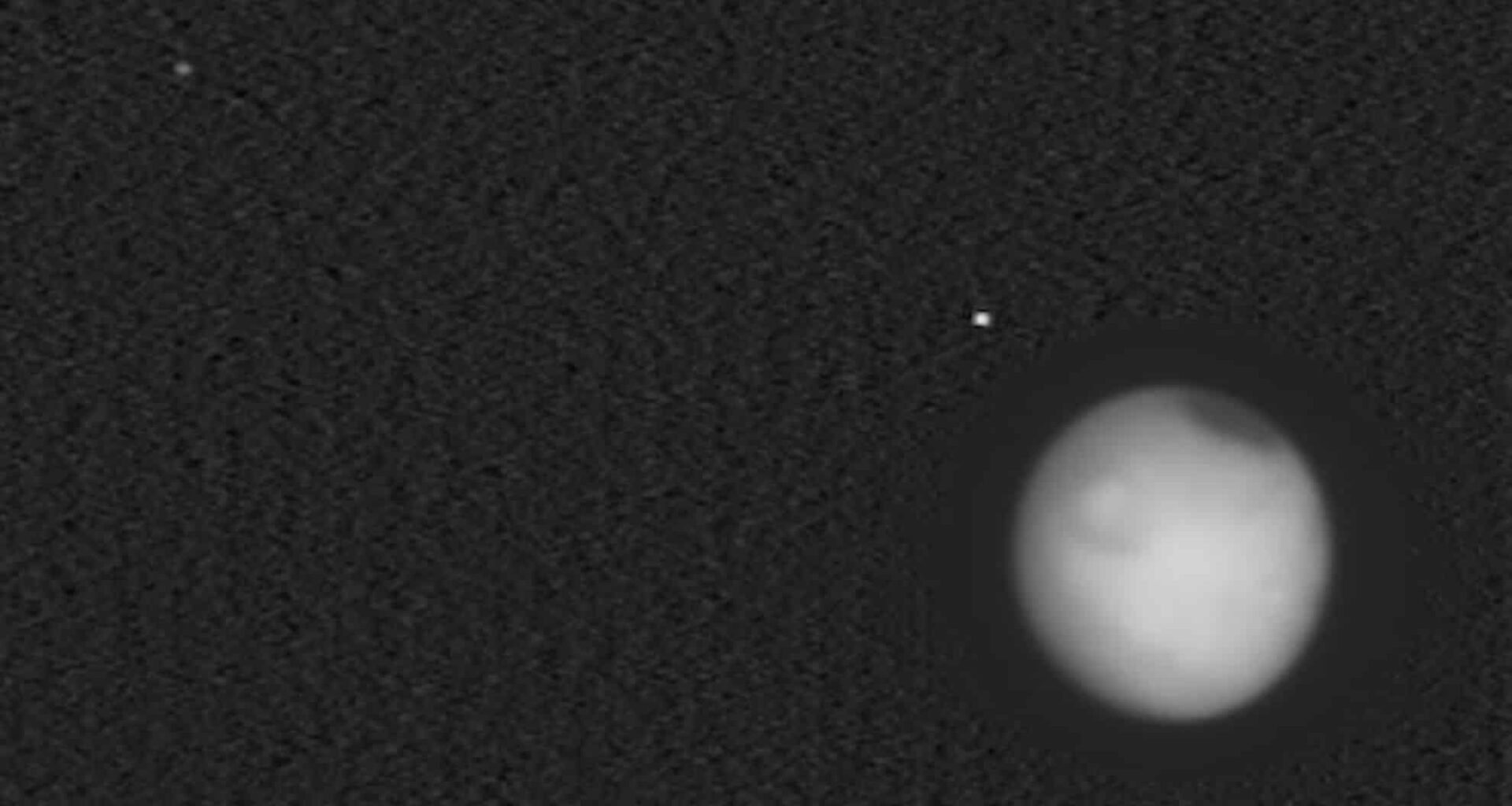In a remarkable moment during its journey toward Jupiter, NASA’s Europa Clipper spacecraft managed to capture a stunning image of Mars and its two moons, Phobos and Deimos, in one frame. This rare celestial alignment provides a striking view of these Martian bodies in infrared light, presenting new insights into our neighboring planet’s tiny moons. The Europa Clipper, originally designed to explore Europa, one of Jupiter’s most intriguing moons, is using its thermal imaging equipment to test its capabilities while en route to its final destination. The image was captured from over 560,000 miles away, marking a significant achievement for the spacecraft and offering new perspectives on Mars and its moons. As NASA continues to explore the mysteries of the outer solar system, this captivating photo serves as a testament to the intricate planning and advanced technology that powers such missions.
Capturing the Trio: A Glimpse into the Far Reaches of Our Solar System
While the spacecraft’s primary mission is to investigate Europa and its potential to harbor life beneath its icy surface, the Europa Clipper made a strategic detour to observe Mars. On February 28, the spacecraft’s infrared camera, the Europa Thermal Emission Imaging System (E-Themis), snapped 200 individual frames over a 20-minute period. The images were then pieced together to form a unified picture of the Red Planet and its moons in a vivid and surreal infrared display.
The striking infrared image shows Mars as the focal point, surrounded by its two moons—Phobos, the larger, innermost moon, and Deimos, the smaller and more distant of the pair. The image beautifully illustrates the heat signatures of the three celestial bodies, with Mars being significantly brighter than its moons. The moons’ dimmer signatures are indicative of their faint glow, with Deimos appearing as a small dot in the upper left, while Phobos is closer to Mars and more distinct.
This moment not only offers a rare celestial snapshot but also provides critical data for testing the spacecraft’s thermal imaging capabilities, which will be essential for studying Europa. As the Europa Clipper continues on its journey, the spacecraft’s advanced instruments will help NASA probe the icy moon’s subsurface, searching for potential signs of life.
Infrared Imaging: Revealing the Hidden Heat of Space
One of the most significant aspects of the Europa Clipper’s image is the use of infrared technology. The spacecraft’s thermal sensors are designed to detect heat rather than visible light, a key distinction in the way space bodies are observed. In this particular case, the spacecraft used the E-Themis camera to capture heat emissions from Mars, Phobos, and Deimos. By capturing these infrared signatures, scientists were able to examine the bodies of Mars and its moons from a completely new angle, revealing characteristics that would be invisible in standard optical imagery.
The process behind capturing this image was not simple. Given the extreme distance between the spacecraft and Mars—over 560,000 miles—scientists had to overcome significant challenges to gather data on these distant bodies. To ensure the moons’ faint signatures were visible, engineers enhanced the brightness of the image during post-processing. This resulted in a clear view of the moons, which are around 250 times dimmer than Mars. The image gives viewers a unique opportunity to observe Mars and its moons in a way not typically available through traditional telescopic observation.
Beyond just a pretty picture, this infrared snapshot provides valuable information about the thermal properties of these objects, contributing to ongoing studies on their composition and potential for future exploration.
Phobos and Deimos: Mars’ Mysterious Moons
The two moons of Mars, Phobos and Deimos, are some of the least understood objects in the solar system. Despite being relatively close to Mars, they remain shrouded in mystery. Phobos, the larger of the two, measures about 14 miles across and orbits Mars three times a day. Deimos, the smaller moon, is about 7 to 8 miles in diameter and takes 30 hours to complete one orbit around Mars. Their small size and irregular shape have led many scientists to speculate about their origins.
One of the biggest mysteries surrounding these moons is their formation. There are two leading theories. One suggests that Phobos and Deimos were once asteroids that were captured by Mars’ gravity. The other theory posits that they may have originated from Mars itself, possibly as debris created by a massive impact on the planet billions of years ago. Despite numerous missions and observations, the exact origin of these moons remains uncertain.
The Europa Clipper’s image offers a rare chance to observe these two enigmatic moons alongside their host planet, a sight that is rarely seen together. The first time both moons were captured in a single image was in 2009 by the Mars Express orbiter, but this latest image offers a fresh perspective, showcasing the moons from a new vantage point.
The Role of Gravity Assists in Space Exploration
One of the interesting aspects of the Europa Clipper’s mission is its use of gravity assists to alter its trajectory. In March, the spacecraft used Mars’ gravity to adjust its path on its journey to the outer solar system. A gravity assist is a technique used by spacecraft to gain speed and change their course by passing close to a planet, using the planet’s gravitational pull. This technique not only helps the spacecraft save fuel but also provides an excellent opportunity for collecting data about the planet being flown by.
This encounter with Mars also allowed the spacecraft to test its instruments before heading deeper into the solar system. By capturing the Mars-Phobos-Deimos trio, the spacecraft successfully verified the capabilities of its thermal imaging tools, which will be used in the future to study Europa in greater detail. Once the spacecraft arrives at Jupiter in 2030, it will conduct a series of flybys over Europa, taking measurements of its surface and interior to learn more about its potential to support life.
